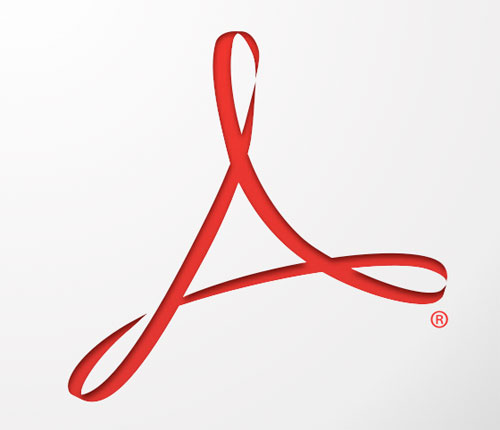
“A company’s logo in vector format can often be ripped from a PDF on their website (such as a report, accounts, or newsletter).
“Simply import the PDF into Illustrator, navigate to the correct page, delete all the gubbins you don’t need and you’re in business. If the PDF has been correctly formatted, you’ll also get the correct Pantone/CMYK values too.
“Sometimes the logo is embedded in the PDF in pixel rather than vector format but that doesn’t happen too often, I’ve had around an 85% success rate using this technique over the past few years.”
Thanks for the tip, Jon.




Comments
In addition to that, most of the documents with logo can be found in their press release or corporate communication section.
cheeky but handy! though what do you do if its password protected?
There object edit tool. Just use it to select an object, right-click & select edit object which will open it in illustrator. Keeps you from getting the other junk that you really don’t care for.
I just wish Adobe played nice with us old Freehand users. I have yet to find a way to make a new Illustrator saved (even saved as an older version of Illustrator or PDF) logo import into my Freehand as a vector. I know, I know, get out of the dark ages. I have used Illustrator off and on since the mid 90s and have yet to find a reason to like it even a little. It is clunky, limiting and reduces my design speed by, easily, 5x. I’ve heard InDesign is a better fit for us ‘old’ Freehand users, but I have not had a chance to test that fully. I took an InDesign class back when the software first was introduced and liked it, but I have not been able to own and really use the software myself as of yet. I’m a freelancer so my budget is non-existent.
As a recent user of Illustrator (migrated from Freehand) I found out that there are a lot to be thankfull for for this migration. On the other hand a lot of Freehand’s strong elements ( and very easy learn and perform) are strongly missed.
Fisrtly let me express my gratitude to Logo design love for their input and inspiring subjects.
As far as today article is concerned, since Illy is by nature a “PDF” programm it is only natural that all pdf files can open as new documents and most if not all elements in that file can be reused.
For Trish, my suggestion to her problem is to open the PDF in Illustrator (since she has been an occasional user) and then re save it or export it as an .eps file and that will probably open very easily in FREEHAND
I have to do this all the time for proposals. I even created a “Search this site for PDFs” bookmarklet to help me:
http://arlodesign.com/blog/2009/12/29/bookmarklet-to-search-current-website-for-pdfs/
I’m not a designer but I know that a isotype or logotype is design with a sort of margin that the user must respect for the sake of legibility. Not only a logo is design but the blanks too. We can’t know what is that space with this technique so use it with caution. Sorry my English, its just a thought.
great idea, but i usually can find vectors of the logo i’m looking for here: http://www.brandsoftheworld.com/
Clever little trick. It saves time and effort redrawing a logo and risking it not looking the same. However it’s always nice to be sent a vector format of a logo, to hinder any re-sizing issues and keeps the logo edges nice and crisp. Thanks.
Eh, I’ve been using that trick for years, in combination with brandsoftheworld.com.
When I need an Illustrator logo in FH, i save it in Illustrator 8 format and usually it works…
This is a neat trick that I have been using for some time now, after a fellow designer put me on to it. I usually type in to Google the desired company name followed by .pdf and then open a few up to check.
Dan
I think you can usually open the PDF in Preview on a mac and then re-export as a PDF and you should be able to bypass the password. Think that should work anyway
I’ve been doing this for years.
BTW, sometimes you can do the same thing using flash “swf” files (if any).
Dan,
It’s very rare to find a corporate brochure or company newsletter that’s been posted onto a public website protected with a password. Opening in Preview can bypass the protection sometimes but I find a better option is to print it through ColorSync, which doesn’t actually print anything it just creates a new version of the file minus the protection (usually).
Martin,
I would agree that the specified “clear space” around a logo should be respected. This technique is just meant to be a short-term solution when time is tight and the item is non-critical. Just don’t put anything else too close to the logo and you should be fine. I would always insist on obtaining the correct logo and guidelines when working with a company on a high-prestige item such as their corporate brochure.
Christian, be careful with brands of the world.com. Too unreliable to confirm if source is the real drawing. I use it only for comping. When i do use it, I group an invisible disclaimer over the a/w that can be seen in selected or in keyline mode, that the logo must be procured from an official source and this is just FPO -mainly because in 3 years time, how do I know who will be using that file. I’d do the same thing with PDF extractions too. Unless you receive a logo through official channels, we have a responsibility, to stop unofficial logomarks making their way into the marketplace, although we do need them….from time to time to make our lives easier.
@Mark:
Oh, I know that botw.com in unreliable.
I use it only for comp or when the client is hopeless – “hey, this is our B.C. scan it to take our logo!” :/
Dan:
http://pdfkey.com/ is the key! It also has the best interface ever :)
I am a designer for a non-profit organization who works with many corporate sponsors who don’t always have their logo readily available. Pulling PDFs from their web site was a trick I started using a couple years back that I’d say I’ve had an 85% success rate with too. PDFgeni is also a good place to do a search for all PDF files:
http://www.pdfgeni.com/
Nice little idea, I’m always hunting their website for logo files in ‘media’ pages and what not and often end up emailing them asking for them – when I should also be looking for any sort of PDF company document as well.
Good thinking!